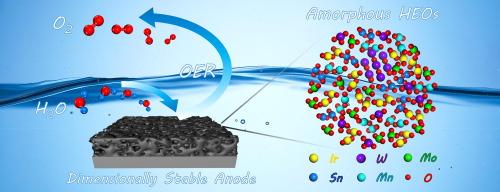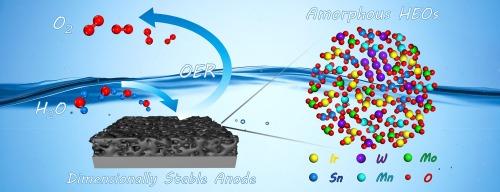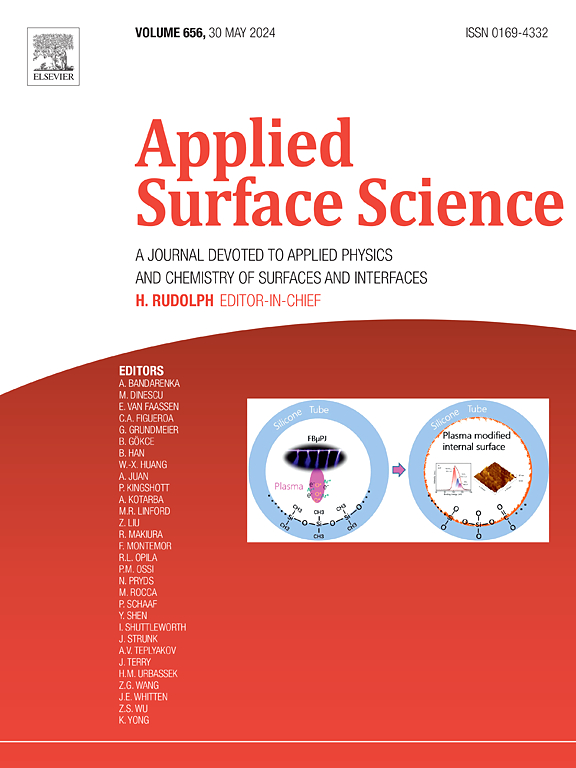Porous amorphous high entropy oxide coated dimensionally stable anode for oxygen evolution reaction in acidic media
IF 6.9
2区 材料科学
Q2 CHEMISTRY, PHYSICAL
引用次数: 0
Abstract
Oxygen evolution reaction (OER) has been the subject of considerable attention as a pivotal reaction in the hydrogen production and hydrometallurical electrowinning. Precious metal-coated dimensionally stable anodes (DSAs) have wide applications in electrochemical industry, functioning as high-performance and stable electrocatalysts for OER. Given the broad development prospects opened up by the advocacy of green energy, the key to the electrochemical industry lies in improving the catalytic performance and durability of DSA. In this study, a novel porous amorphous Ir-based high-entropy oxides-coated DSA was prepared by thermal decomposition method, and its OER activity and durability in acidic media were investigated. The Ir-based high-entropy oxides coatings exhibit a hierarchical porous morphology at the surface, coupled with an amorphous structure. The coatings display a high proportion of Ir3+, unsaturated bonds and oxygen vacancies/hydroxyl groups, which collectively impart excellent OER activity. The achievement of current densities of 10 and 100 mA cm−2 at potentials of 1.45 and 1.51 V vs. RHE in 0.5 mol L−1 H2SO4 solution represents a significant outcome. The coatings demonstrated remarkable electrochemical durability without decay after 5000 cycles and are able to withstand a cumulative 504-hour durability test under the current density of 1000, 2000, and 3000 mA cm−2.


用于酸性介质中氧进化反应的多孔非晶高熵氧化物涂层尺寸稳定阳极
氧进化反应(OER)是制氢和湿法金属电积过程中的关键反应,一直备受关注。贵金属涂层尺寸稳定阳极(DSAs)作为高性能、稳定的 OER 电催化剂,在电化学工业中有着广泛的应用。鉴于倡导绿色能源所开辟的广阔发展前景,提高 DSA 的催化性能和耐用性是电化学工业的关键所在。本研究采用热分解法制备了一种新型多孔非晶态 Ir 基高熵氧化物包覆 DSA,并考察了其在酸性介质中的 OER 活性和耐久性。铱基高熵氧化物涂层表面呈现出分层多孔形态,并具有非晶结构。涂层显示出高比例的 Ir3+、不饱和键和氧空位/羟基,这些共同赋予了涂层出色的 OER 活性。在 0.5 mol L-1 H2SO4 溶液中,相对于 RHE 的电位分别为 1.45 和 1.51 V 时,涂层的电流密度分别达到 10 和 100 mA cm-2,这是一项重大成果。涂层在经过 5000 次循环后显示出卓越的电化学耐久性,没有出现衰减,并能在 1000、2000 和 3000 mA cm-2 的电流密度下经受 504 小时的耐久性测试。
本文章由计算机程序翻译,如有差异,请以英文原文为准。
求助全文
约1分钟内获得全文
求助全文
来源期刊

Applied Surface Science
工程技术-材料科学:膜
CiteScore
12.50
自引率
7.50%
发文量
3393
审稿时长
67 days
期刊介绍:
Applied Surface Science covers topics contributing to a better understanding of surfaces, interfaces, nanostructures and their applications. The journal is concerned with scientific research on the atomic and molecular level of material properties determined with specific surface analytical techniques and/or computational methods, as well as the processing of such structures.
 求助内容:
求助内容: 应助结果提醒方式:
应助结果提醒方式:


